Frenchies are designer dogs known for special boutique colors, including Isabella, lilac, etc., but perhaps the toughest one to get is a blue fawn French Bulldog. Why is this pattern and color combination so sought-after?
The answer is simple — to produce a litter of blue fawn Frenchies, a breeder will need to invest a lot of time and money to find healthy parents that carry the necessary genetic makeup for a blue fawn offspring.
Increased demand for more genetically complex colors means that more and more Frenchie breeders are trying to establish their own bloodlines in a couple more exclusive colors to meet buyer expectations.
I believe a closer look into dog genetics is necessary to realize how deep breeding a blue fawn Frenchie is, so that is where we will start.
Dexter’s Laboratory And The Blue Fawn French Bulldog
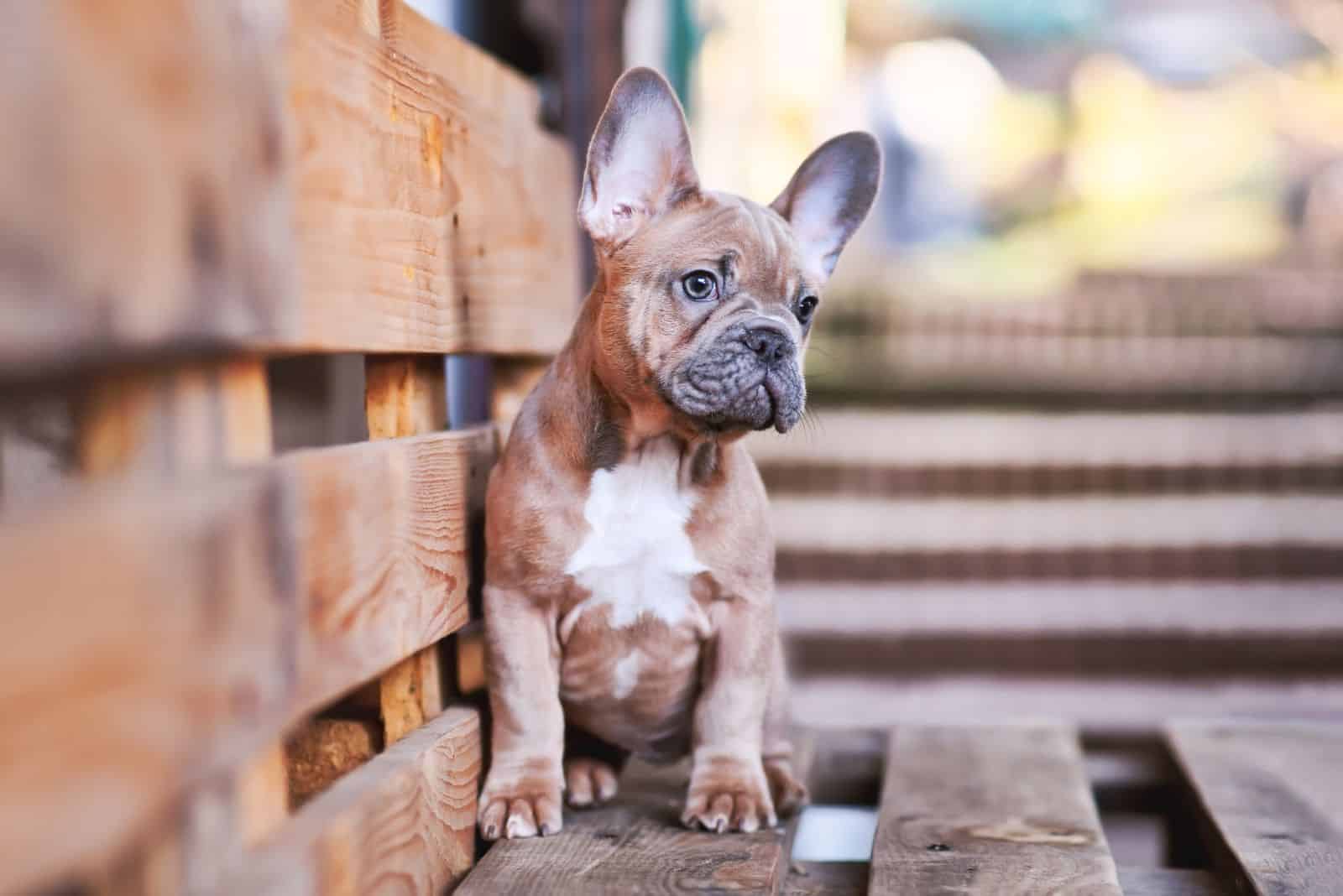
A Frenchie puppy might not immediately express the color it will have as an adult, and people who do not know that often think the breeder is trying to trick them.
The main coat color of the blue fawn Frenchie is fawn, with a melanistic mask expressed in a “blue” color that is actually a light shade of grey. Naming this nuance of gray “blue” is purely a marketing move because it sounds more exotic and appealing.
The nine standard coat colors recognized by the American Kennel Club do not include blue fawn. Still, this combination is not that distant from a fawn with a black melanistic mask, which is a standard coat color.
Another thing to keep in mind is that a fawn coat is not difficult to produce, nor is it rare in Frenchies. The process is by no means simple in terms of genetics, but a blue coat follows a genetic path that is easier to explain.
The Genesis Of A Fawn Coat And Blue Melanistic Mask
Dominant and recessive genes alone are not the only factor determining which color a French Bulldog will be. Loci (locations on a gene) have two genes on them that can be variations of the dominant gene (alleles).
Almost all loci interact with each other in a chain of command, and in doing that, they control how much of which pigment will be produced and where it should be placed. Eumelanin (black pigment) and phaeomelanin (red pigment) are responsible for all possible color combinations.
It is the locus where genes are found that flips the switch in deciding which pigment will be produced at what point. For a fawn coat, it all starts on the E locus (expression). This is the first obstacle genes have to jump over to be on their way to a fawn coat.
Two dominant genes or a dominant and recessive gene on the E locus will signal to the K locus that only the black pigment will be produced at that moment. If the opposite happens and two recessive genes are paired on the E locus, only red pigment will be produced.
Once the decision-making power is on the K locus (dominant black), there will be another check to see which pigment is going to be produced. For a fawn coat, there need to be two recessive genes on the K locus (kʸ/kʸ) that will pass on the responsibility to the A locus.
The ASIP (Agouti) And The MC1R Gene Make The Color Tick
A protein named Agouti Signaling Protein (ASIP) controls essentially everything regarding the two pigments — which one is produced, how much of it, when is it time to switch, where on the coat or hair a particular pigment will be, etc.
However, it cannot act of its own accord and works closely with the MC1R gene, which controls both eumelanin and phaeomelanin production. Variants of this gene are called alleles, and they will give a dog particular markings, two or even three colors, etc.
All of this happens on the A locus where the Agouti gene resides. The most dominant gene in this locus is the Aʸ allele. Paired with any other variation, it will always be dominant. So a dog parent can be a carrier of the gene without expressing the phenotype.
This Aʸ allele is responsible for producing a sable or fawn color in dogs, which means the blue fawn French Bulldog’s coat is almost at its destination. What is left to be done is creating the blue melanistic mask, which requires the involvement of the dilute gene on the D locus.
Note that there are several alleles on the A locus that can produce quite different coat patterns depending on their dominance and pairing. For example, the brindle gene (Kᵇʳ) is on the K locus, but the A locus must have at least one dominant gene present.
D Locus, The Final Stop
Although the hero of this chapter is the D locus, the Agouti gene on the A locus will still be leading things from behind the scenes. First, let us get back to the start, the E locus.
It is the first stop that will determine which pigment will be produced, and with the choice of K locus (black pigment), the dominant gene pairing on it decided that black will be produced first. The Eᵐ locus (melanistic black mask) is similar to the E locus but affects only the nose, eyes, and feet.
Since black is the dominant color on the K locus, the Eᵐ dominant gene will signal that eumelanin production should be started for these parts of the body. However, the Eᵐ locus interacts with the D locus, which only controls how much pigment is produced.
A pairing of two recessive genes on the D locus (d/d) will mean that black pigment production, ordered by the K locus, will be inhibited once the D locus is in charge. Without enough eumelanin, the muzzle, feet, and/or eyes can result in varying shades of black.
A blue fawn French Bulldog will, obviously, have a blue melanistic mask, favor of the D locus, with a high chance of sporting light blue or light brown eyes. Genetic research on the topic of genes that control eye color is still ongoing, and other undiscovered alleles or loci might have an effect.
Why Is The Blue Fawn French Bulldog So Exotic, Then?
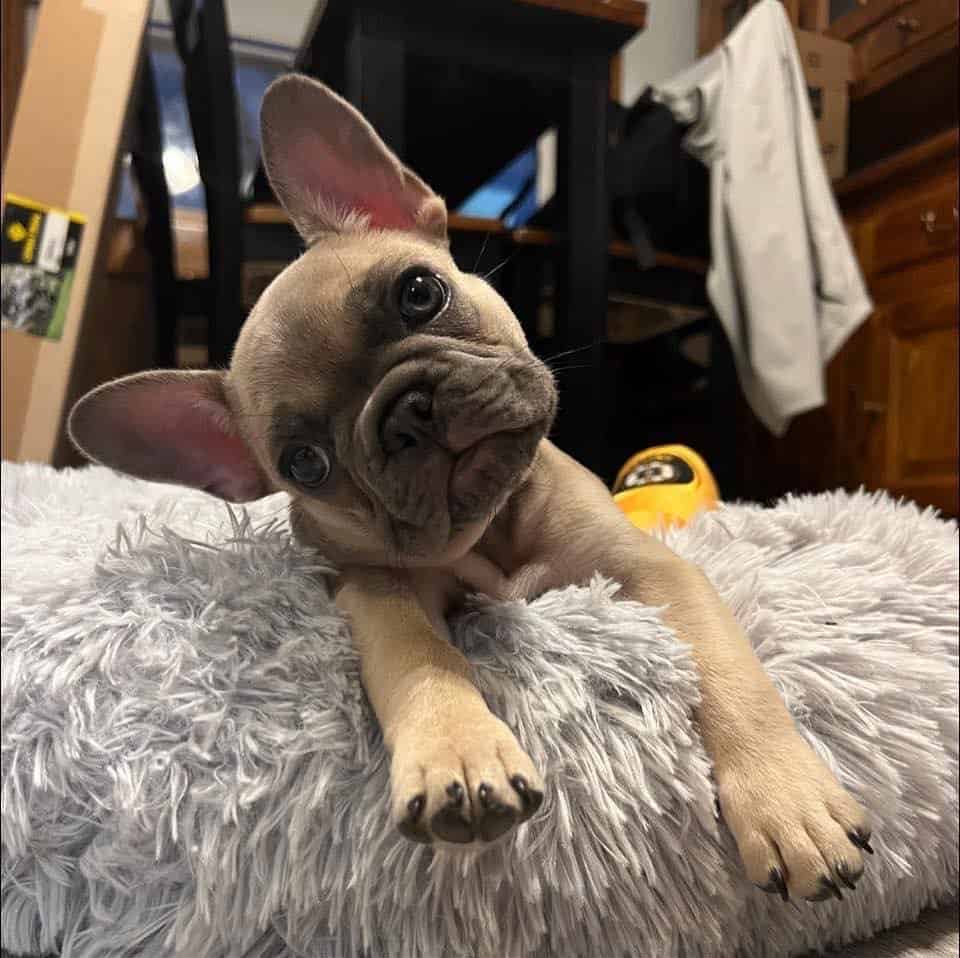
Well, the fawn color is a common coat color that can manifest itself in shades of yellow that range from a saturated cream to a reddish variant but is most frequently expressed as something in between (gold).
The tough part is getting the blue melanistic mask that carries diluted black on the paws and potentially light blue or light brown eyes into the mix.
Dogs that are fawn usually have a black melanistic mask, which means the second Frenchie parent has to have the blue phenotype (expression of diluted black) to give only the possibility of a blue melanistic mask.
Multigenerational breeding does increase the chance, as its whole concept is trying to instill certain features (diluted coat in the case of blue fawn). This takes a lot of effort, time, and investment in the right dogs, in turn pushing breeders to charge a premium for it.
This is not a rare French Bulldog color, but a rare combination of markings and main coat. For example, a blue Frenchie will have all of its coat, including muzzle, paws, and eyes (in most cases), diluted.
All a breeder has to do to get a uniformly blue French Bulldog is pair two blue Frenchie adults, and the offspring will one hundred percent have the blue phenotype.
Blue Fawn Frenchie Genetics Can Cause Other Health Issues
Selective breeding for cosmetic purposes only, i.e. coat color, is a topic that draws attention in terms of ethics. Most breeders that have blue fawn French Bulldog puppies for sale will tell you it is a purebred dog no different than other Frenchies with standard colors.
While that is true, they are likely purebred French Bulldogs, constantly breeding and keeping recessive genes in bloodlines can cause genetic mutations that affect the skin, eyes, and even ears.
Brachycephalic breeds like this one are already predisposed to genetic health problems associated with airways, allergies, and anatomical abnormalities, so adding to the pile is considered unethical.
Blue merle Frenchies and other breeds too are constantly mentioned in these discussions, as there is evidence of an increased chance of congenital conditions like deafness, skin disease, or even cancer when two merle dogs are mated.
Most of the results indicating the above were noted in dogs that, in addition to having a merle or double merle coat, display blue eyes. This breeding practice is generally regarded as unethical, and a breeder that cares about breed preservation will not employ it.
Color Dilution Alopecia
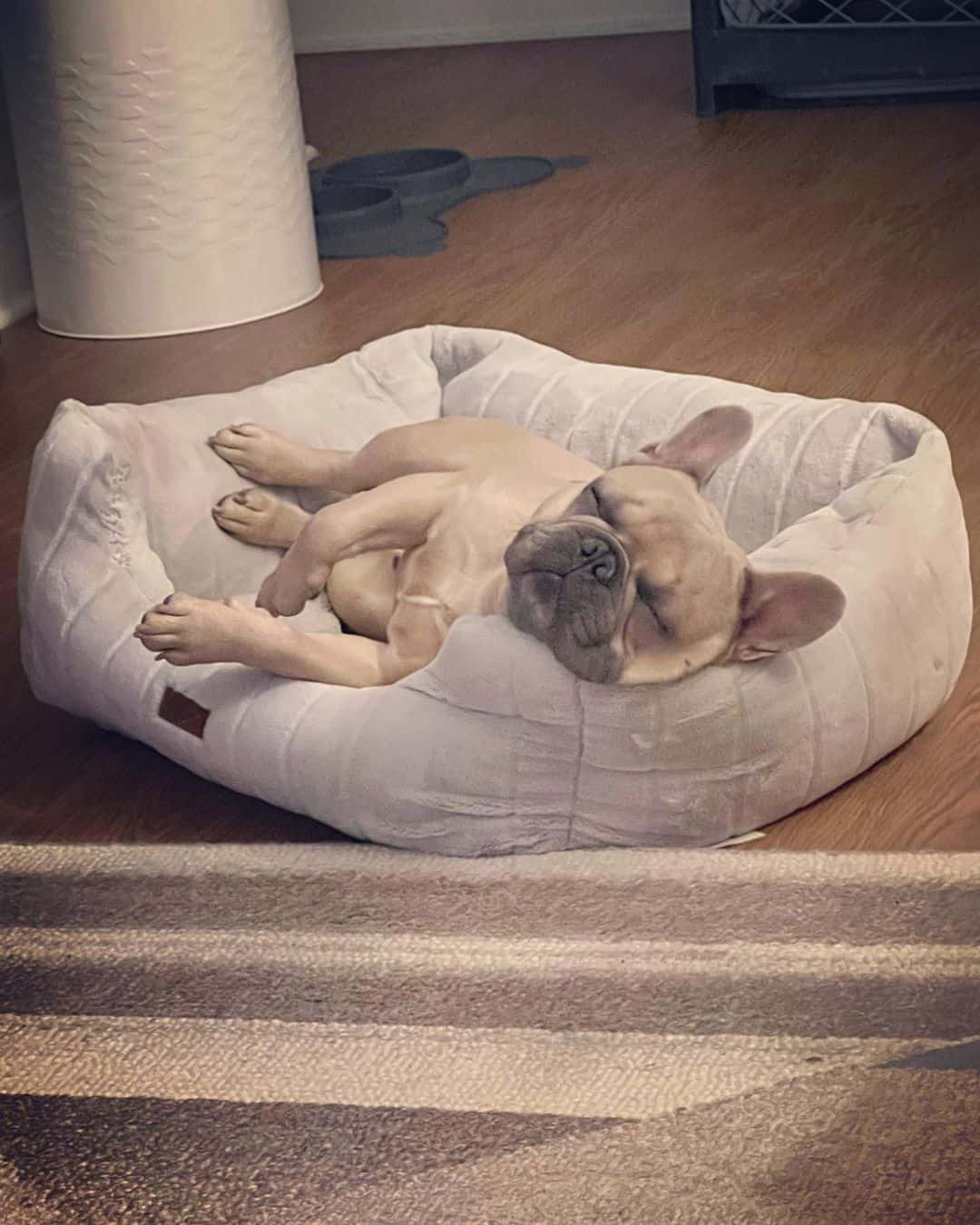
Dogs that carry the burden of having a diluted coat color, like blue or fawn (in the blue fawn French Bulldog, it is both), are at an increased risk of developing CDA.
By definition, the symptoms are skin that itches or flakes, poor-quality of hair, or bald patches on the body. These signs of the disease most frequently show up at six months of age, so a blue fawn French Bulldog puppy will look completely normal up until that half-year point.
Although veterinary medicine and research on this genetic condition have not shown conclusive results about why or how it affects the body, the effects are clear — CDA directly affects hair follicles in that the affected ones die off without the possibility of regrowth.
Loss of hair or poor coat quality is the only real danger stemming directly from color dilution alopecia, but exposed skin, without the protection of the hair, can be susceptible to injury from excessive scratching or foreign objects and secondary infection following the skin damage.
This condition is incurable, but a variety of medical shampoos, ointments, dietary adjustments, and antibiotics (oral or topical) for more severe infections are the most common therapy. Using a soft brush and avoiding putting too much pressure on the skin is recommended.
A blue fawn color on your Frenchie will not mean CDA is a given, but health should be a consideration when choosing a puppy based on coat color. Blue pied (piebald) colored Frenchies or those with a lot of white on the coat further increase the chances of genetic abnormalities.
Brachycephalic Airway Syndrome
The marquee trait of blue-fawn French Bulldogs is their flattened muzzle. Since this was a feature that was bred intentionally, its anatomy carries certain airway problems too.
Partial air obstructions in the upper respiratory system include laryngeal collapse, narrowed nostrils or trachea, or elongated soft palate. For this reason, you can hear Frenchies, Pugs, Bulldogs, and other brachycephalic breeds snoring intensely.
Additional symptoms are tachypnea or fast breathing, reverse sneezing, constant panting, coughing when eating or drinking, etc. You will find that a French Bulldog will easily fatigue during physical exercise and show signs of labored breathing.
Cumulatively, all these issues can be worsened if your dog is obese, allergic, or has some other underlying conditions. They can also be allergic to vaccines, so make sure you do allergy tests prior to vaccination.
Allergies
Whether a blue fawn Frenchie’s allergies are environmental or from dog food, the symptoms most commonly affect their skin too. Both humans and dogs find seasonal allergies very annoying.
Springtime can make walks in the park become nightmares with all the pollen from trees, grass, and weeds flying around. Even the inside of the home is not safe — dust mites, dust, or mold present a danger for the Frenchie’s airways.
Since we already saw the skin of a blue fawn French Bulldog is more sensitive due to CDA, some grooming products like shampoos can irritate the skin, causing itchiness, redness, or dry skin.
Excessive scratching can break the outermost layer of the skin, allowing germs to enter the wound, so make sure you keep an eye out for sores, pustules, and areas with discharge on your Frenchie’s skin.
The treatment for allergies includes antihistamines, removing the allergens from the environment, or avoiding taking your dog into areas of dense vegetation in the spring.
Food allergies will almost always have diarrhea, vomiting, and general digestion problems as the main symptoms. French Bulldogs can have skin symptoms in line with other allergies if not diagnosed and treated in time.
Worst case scenario, your Frenchie will be allergic to animal meat protein, grains, or other ingredients found in basically all dog foods on the market. This is not that common, but if it does happen, hydrolyzed protein dog food is the only way to avoid an allergic reaction.
Otitis Externa (Ear Infection)
Although the Frenchie’s ears are not floppy, they seem to have trouble dealing with ear infections. Viruses, bacteria, fungi, autoimmune disorders, and other underlying health conditions are all causes of otitis externa.
The first symptom your dog will display is incessant ear scratching. It will, of course, cause more damage and allow easy entry of germs into the body. If the dog already suffers from a condition that weakens the immune system, the ear will quickly become inflamed.
Other signs of otitis externa include head tilting, redness, sore skin, pus, or colored discharge. You should probably call the vet when you notice excessive scratching and avoid complications.
If not treated immediately, the infection can spread to the middle and inner ear or get into vital organs through the skin blood vessels the pathogens infiltrated. The treatment involves reducing inflammation with NSAIDs.
More severe cases will require antibiotics or antifungal oral medication to alleviate the symptoms. Ointments are often prescribed for dogs with an infection that does not go past the skin or simply reduces the chance of recurring infection.
Pyoderma
This condition is characterized as a bacterial infection of the skin and can be caused by any bacteria found in dirty bowls, soil, urine, or feces. Frenchies are decent diggers, and if you go on trips to the wild, the soil is your number one enemy.
A short smooth coat means that they get some water resistance, but the undercoat can soak up plenty of water from puddles or snow. Trapped moisture is a place for germs to multiply, and combined with soil, dust, or residual feces, it can easily spread on the epidermis.
Pyoderma usually manifests itself on skin folds such as the armpit, under the tail, the groin, the face, or similar humid areas. A fat belly due to obesity is a prime location for bacterial infections.
Pustules are by far the most frequent symptom of this condition, and if you ever saw a pimple on your face, that is what you should look for on your Frenchie’s skin. The middle of the pustule is filled with pus that can be white, off-white, or light yellow.
Dogs scratch these itchy spots, so sores, redness, swelling, and discharge are some other signs that point to a bacterial infection. However, the majority of cases are treated with oral antibiotics.
That therapy will last up to a month, after which you will probably use antibiotic ointments to prevent reinfection. Practicing good hygiene with your dog is the easiest way of avoiding infections from external sources.
What You Get For The Price Of A Blue Fawn French Bulldog
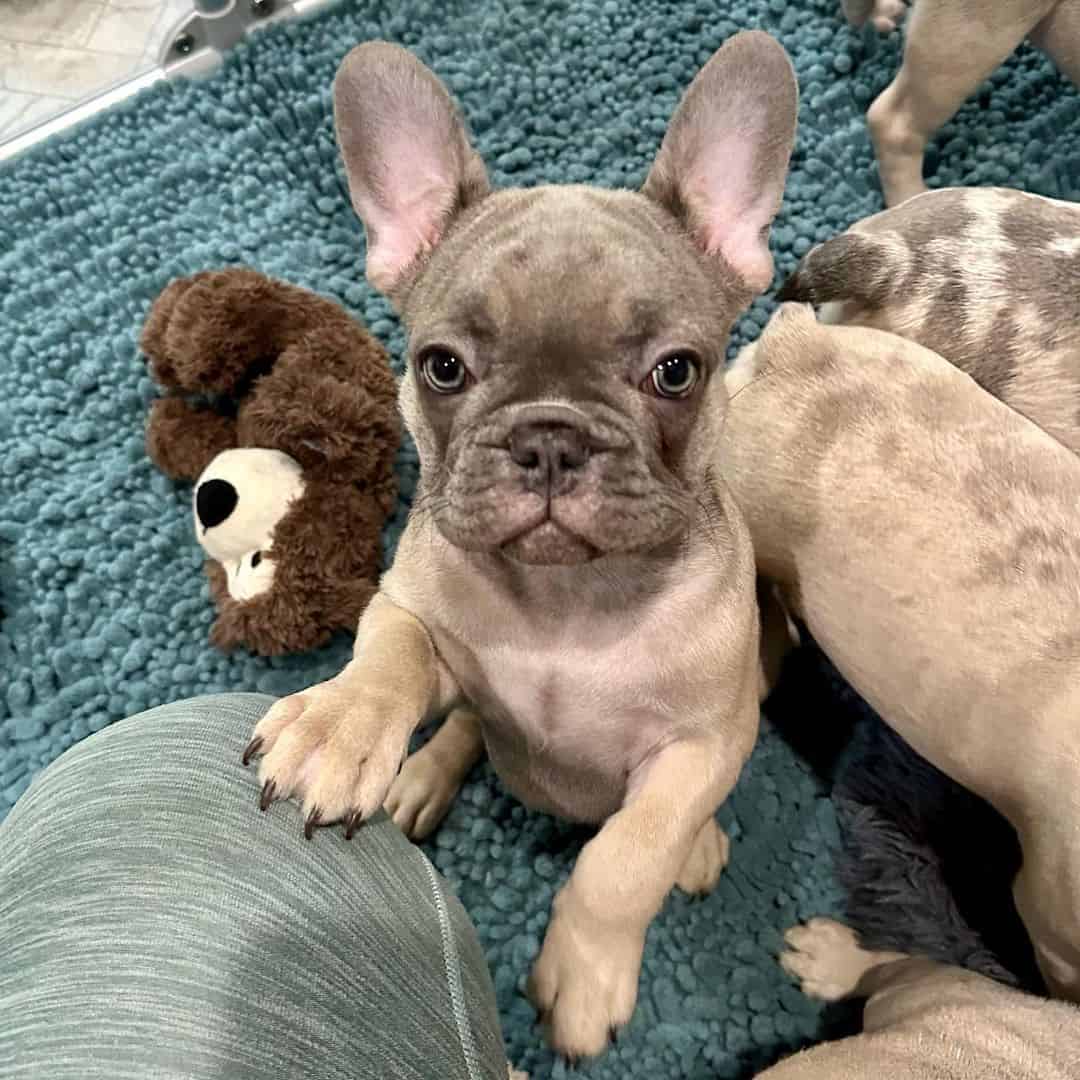
This particular combination of a blue melanistic mask and fawn main coat on a designer dog will be quite costly. The prices range anywhere from $6000 to upwards of $7000.
As previously explained, getting to the point where you can expect a litter to have a blue fawn puppy is time and cost-intensive. Breeders who produce these types of coat combinations in French Bulldogs are considered profiteers by many others.
However, I would disagree that they are the only profiteers, as the inception and origin of the French Bulldog breed itself lie in cosmetic and inherently financial motivation.
With such a high acquisition cost, you will probably spend a lot of money on maintenance costs too. Getting the comfiest bed, best brush, best collar, and best dog food for your blue fawn Frenchie can amount to more than a thousand dollars.
If some health problem arises, expert veterinary services like veterinary dermatologists, ophthalmologists, etc., are not cheap or widely available.
There is a lot to consider before buying a blue fawn French Bulldog, mainly due to its increased chance of developing inherited conditions due to the way it was bred.
For Those Who Want To Know About Blue Fawn French Bulldog Looks And Temperament
Bred primarily as a companion dog of small size and odd looks, the blue fawn French Bulldog is like any other Frenchie, except for the unique but controversial coat color.
They grow to be eleven to thirteen inches tall and should weigh under twenty-eight pounds. A difference in size is negligible between female and male dogs. Being pretty muscular and compact for its size, the French Bulldog is a force to be reckoned with.
Having a very short, almost flattened muzzle makes them a brachycephalic breed, so some anatomical irregularities can make life harder for them. The eyes protrude slightly, but they are more known for their medium-sized bat-like ears that are carried erect.
The head is of a square shape and proportional to the strong neck that connects to a broad chest and well-muscled shoulders. Overall, the body shape of the Frenchie is more stout than athletic.
With back legs that are longer than the front, the Frenchie has the lower back a little more elevated, which makes for a subtle arching of the back. There is moderate tapering from the shoulders toward the rear end of the dog.
The tail can be straight or screwed, but a curly one means disqualification on dog shows, according to AKC dog breed standards. Similarly, it should always end with a point, never stubby.
There is a mini version of the French Bulldog, too, that has the same physical traits but in a smaller package. We have an in-depth article on the mini Frenchie if you want to know more about it.
Coat And Grooming
Their coat is smooth and short and should not feel fluffy. Being a popular dog breed means there are plenty of coat colors too, and more have been added to the list in recent years.
In addition to the breed standard brindle, cream, fawn, white, and combinations of fawn brindle and white, brindle and white, fawn and white, white and fawn, and white and brindle, you can find non-standard ones too.
Those include the blue brindle, blue fawn, and more than fourteen other colors and combinations you can read about in our article dealing with twenty-five French Bulldog colors. These are also known as rare since neither the French Bulldog Club (FBC) nor AKC recognizes them as standard.
Grooming them is a piece of cake. One or two short sessions per week will keep everything tidy and shining, but they are moderate shedders. People with dog hair allergies will not appreciate their non-hypoallergenic coat properties.
The Blue Fawn French Bulldog Is A Bigger Thinker Than You Might Presume
Ranking at number four of most popular dog breeds, the blue fawn French Bulldog and his differently colored counterparts are amazing family dogs. Boundless love for the family and a particularly good feeling for dealing with young children are trademarks of the breed.
This means that they are pack dogs that do not like spending a lot of time on their own. Separation anxiety is definitely a common behavioral issue in Frenchies, so make sure you have plenty of interactive toys that will mentally stimulate them while you are away from home.
On the topic of mental stimulation, they are very trainable and love doing all sorts of tricks. The crazier the trick, the better it will stick. Energy levels are not the highest out there, but thanks to their size, you will be able to satisfy their exercise needs even in an apartment.
A house with a large yard will surely be more adequate, but they can be impressive couch potatoes too. However, do not neglect their susceptibility to obesity by giving them treats all the time.
Expect your Frenchie to be ready for play any time of the day. Whether you have strangers around or just the family, everyone will be entertained and content with the French Bulldog show.
Socialization
Cohabitating with other pets, especially dogs, will not require any special effort from a dog owner’s side. They will love playing with one of their own kind, and the odd cat or parrot can be a great way to kill some time.
Make sure to introduce your Frenchie puppy to whatever animals you have in a controlled manner, as they tend to get scared if the approach is too aggressive or sudden. Research has shown that small dogs are less self-confident than larger dogs due to their size and interaction with the world.
I know from personal experience that teaching boundaries through obedience training will successfully prevent jumping on you, your family, or the guests you are having around. This is unwanted behavior that can escalate into aggression if not sorted.
Diets And Good Eating Habits
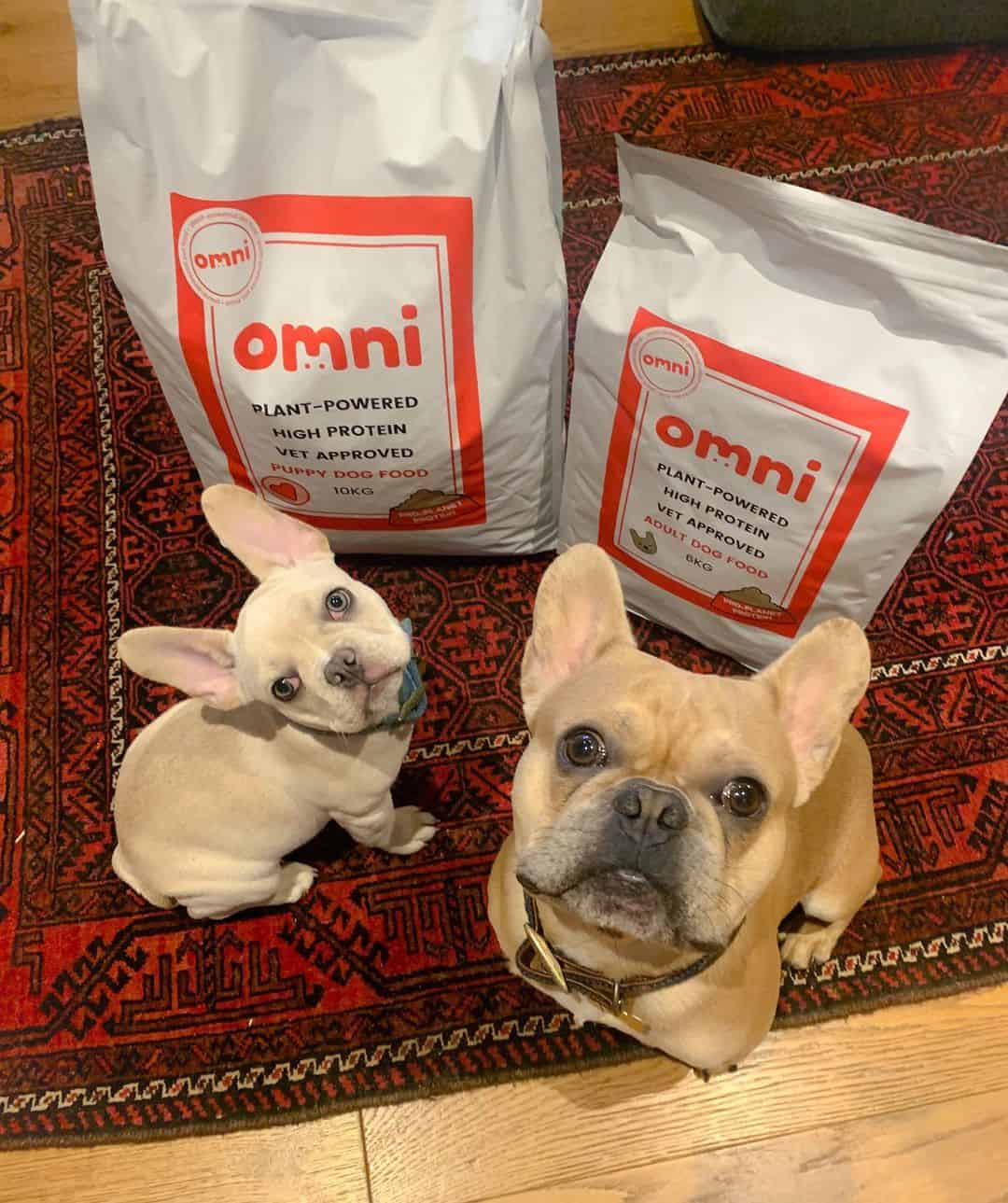
Feeding a small dog like a French Bulldog is not as easy as it appears. Their small but muscular body can deceive them into thinking they are not fat, but that assumption would be incorrect.
Frenchies have huge appetites and will until you remove the food from them. Watching closely their daily calorie intake will help prevent unnecessary weight gain or obesity. Treats count as food, too, so you should not consider them as “outside the scope of feeding”.
Dry Food
There are plenty of diets your French Bulldog can follow. The most time and cost-effective is commercial dry food — kibble. You can store it wherever you want due to its long shelf life. It can be dosed precisely with the use of cups, so you will save time on meal preparation.
Another advantage is that you can mix it with other foods like vegetables or bone broths. Most of the necessary nutrients for your pup’s development or adult dog maintenance are contained in high-quality kibble, which makes the use of supplements unnecessary in most situations.
Make sure to keep a bowl of fresh water at all times if you feed your dog exclusively dry food. Hydration is crucial for the proper function of metabolism and vital organs.
Canned Food
This is another good option that has a long shelf life but not as long as kibble. Canned food is a little bit more clunky but will provide water content too, which means less dry matter protein. However, there will still be enough for an almost comprehensive meal.
Mind you, wet foods can upset a puppy’s stomach, so avoid feeding your Frenchie wet foods before at least six months of age. Runny stools are not something you want in the darkest corners of your house.
Combing kibble and wet food is a good take on variation in a diet, but make sure to buy only foods that are approved by The Association of American Feed Control Officials (AAFCO). Their mark of approval means the food has good nutritional value and is safe for your pet.
Raw Diet
If executed properly, a raw diet will probably be the best thing you can do for your dog. Most of the nutrients are preserved better in raw food than in processed commercial products, so your dog will eat straight from the source.
Owners often speak highly of raw diets and report a few benefits, including better coat quality, more energy, less smelly breath, and substantially smaller poops, which is pretty nice. Still, there is no science proving any of this, so you will have to see it for yourself.
The challenges that come with a raw or B.A.R.F. diet (Biologically Appropriate Raw Food) are multiple. If you often work late hours, preparing a raw food meal will take more time than just putting a few cups of kibble in the bowl.
Finding high-quality produce can be tough sometimes, and the price of animal protein, animal organs, bones, fresh veggies, and seeds or nuts is quite high. Freezing and packing the meals yourself is another task that will eat away at your time.
Veterinarians and experts suggest staying away from raw diets if you are not well-versed in finding fresh meat and organs due to the danger of bacterial infection. Your entire family is at risk of salmonella or some other germ living in the meat.
Additionally, creating a comprehensive meal from raw ingredients is not easy to do, which is why supplements will be necessary to provide a fully nutritional diet to your dog. If you want to know more about it, read this article on feeding a raw diet to French Bulldogs.
Conclusion
Feeling exclusive is great, but the risks of owning a blue fawn French Bulldog can hamper that enthusiasm. A high acquisition cost and susceptibility to genetic health issues due to breeding practices are something to consider prior to looking for breeders.
There is nothing wrong with owning a Frenchie, but financially and time-wise, you will need to dedicate a good portion of both to provide the best life possible for the dog. If you feel up to the task, let nothing stop you and make it happen.
On the other hand, if you are weighing things up and worrying about health problems, you might be better off with some other designer dog breed that has fewer health issues but plenty of color options.
Regardless of choice, it is most important to know what you are getting with your purchase, and I hope this article aided the making of your decision. As ever, stay informed, and I will write to you soon.
Read Next: Revealing The Blue American Bulldog Enigma















